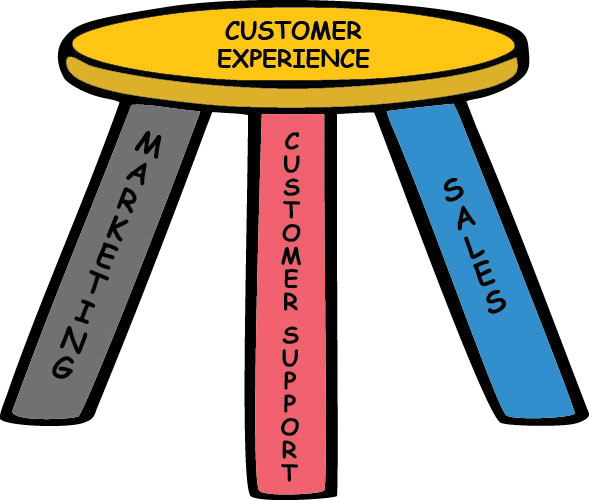
Customer Experience Management:
A Three‑Legged Stool



When it comes to your business, it’s a no-brainer that customers are the successful ingredient to success or failure. So why are companies still struggling to keep their customers happy?
It’s because most companies fail to view the customer experience as a multifaceted strategy—a three-legged stool, with each leg of the stool an equally critical component in finding and retaining customers, hopefully for a very long time. Without one of the legs, the stool would fall.
Leg #1: Marketing.
Companies often invest most heavily in their marketing and sales functions. After all, these are the folks whose positions exist solely to acquire more customers. Most marketing teams use innovative and sophisticated systems to find prospective buyers, then they hand them over to the sales team.
Leg #2: Sales.
The sales team will often go to the ends of the earth to develop relationships with qualified prospects and, over time and with great care, convert them to paying customers. In many respects, sales is an obvious part of any company’s customer experience strategy.
Leg #3: Customer Support.
Once a customer signs on, it’s up to the customer support team to understand their unique business needs and care for them throughout the rest of the relationship.
In many companies this stage is the weakest link in their customer strategy, yet it’s arguably the most critical. Customer service (if done well) will have the longest relationship with a customer. It is during this stage of the customer experience where customer issues are most resolvable and relationships the most recoverable. It is also where customer turn-over happens the most.
If you lose a sale, you never really had the customer anyway. But if you lose a customer, you’ve lost not only today’s business, but also future sales and possibly even reputation.
So how can you equip your customer support team with the tools and resources to make customer service an equally strong leg of the three-legged customer experience stool? Here are a few best practices:
- Understand the whole customer.
Most customer service teams are built around individual interactions, focused entirely on “tickets.” A customer reaches out to the support team with an issue, a ticket is assigned, the issue is addressed, and the support representative moves on to the next ticket. In a business to business environment, this limits visibility at the customer level. Imagine 5 different people at the same company open tickets about the same issue. A ticket-based model means 5 different agents are addressing the 5 different tickets, and no one is aware that this is a recurring issue for the customer, because they can’t see tickets at a customer level. So when the customer leaves them for a competitor, everyone is surprised – they never even knew there was a problem. By contrast, the most strategic customer support teams manage issues at a customer level - not just one problem at a time.
- Automate operations.
Bringing your customer support operations together within one unified system ensures that every customer support representative has the information they need at their fingertips - and that the information is the most current. Cloud-based software is especially vital for companies whose support agents are spread among multiple offices or even multiple regions of the world.
- Collaborate as a support team.
Customers want their issues resolved as quickly as possible. They don’t want to be escalated through multiple agents. The best customer support teams use a collaborative approach where support agents can get answers from colleagues; internal groups can have conversations about customers or tickets; and product developers and sales team members are kept apprised of customer issues. Exceptional service draws upon the collective wisdom of the group and enables first-call resolution.
- Anticipate the customer’s needs before they happen.
Superior support teams anticipate customer pain points and develop solutions before the customer even realizes it. Look for customer support software for your team that helps you track issues by product, user, or company to identify trends as they’re developing, and manage your customers at a company level.
Even if your customer experience stool is a little wobbly right now, by moving your service team to a more collaborative and customer-centric model, you’ll deliver support that’s as integral to the customer experience as marketing and sales. After all, better support leads to happy customers, and happy customers lead to more sales. ![]()
TeamSupport is an award winning, Web-based service-desk solution optimized for team collaboration. For a free two-week trial, visit www.teamsupport.com/web-help-desk-support-free-trial/.